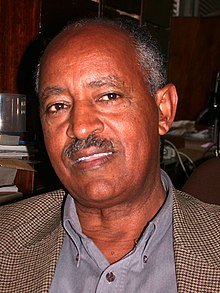Berhane Asfaw
Berhane Asfaw ( Amharic በርሃነ አስፋው ; born August 22, 1954 in Ethiopia ) is an Ethiopian paleoanthropologist . He became known in specialist circles through several finds from early pre-humans . Berhane Asfaw primarily researches the fossil sites east and west of the Awash in the Afar Triangle and was the author of the first description of the species he named Australopithecus garhi . He was also the co-author of the first description of Chororapithecus abyssinicus and Ardipithecus ramidus .
Career
Berhane Asfaw first studied geology at Addis Ababa University , where he earned his bachelor's degree in 1980 . Parallel to his studies, he taught chemistry and physics at a high school in Gonder in 1976/77 and then worked for the Ethiopian antiquities authority belonging to the Ministry of Culture until 1980. Afterwards, thanks to a scholarship from the Leakey Foundation, he continued his studies at the University of California, Berkeley , which he completed in 1983 with a master's degree in anthropology . In 1988 he was the first Ethiopian to receive a doctorate in anthropology - also in Berkeley, from John Desmond Clark and Tim White .
In 1988 Berhane Asfaw returned to Ethiopia, where, on the basis of a special permit, the Ethiopian government gave him permission to explore new, promising paleoanthropological excavation sites; In 1982 the government announced a moratorium aimed at protecting the cultural heritage of Ethiopia and suspended all excavation permits previously granted to foreign paleoanthropologists. From 1990 to 1992 Asfaw was director of the Ethiopian National Museum, in which, among other things, Lucy is kept.
In 1994/95 Asfaw taught anthropology as a visiting professor at Rutgers University , since 1997 he has headed the private-sector Rift Valley Research Service in Addis Ababa and is co-director of the Middle Awash Research Project , which was founded in 1981 by John Desmond Clark and since 1990 by Tim White is headed.
In 2008 Asfaw was elected to the National Academy of Sciences .
Research work
Berhane Asfaw works as an expert in paleoanthropology in the Middle Awash Research Project and supports the excavations at the Middle Awash at the same time through the Rift Valley Research Service . Since 1988 he has ensured that around a dozen of his compatriots have been able to study anthropology abroad.
Asfaw became known beyond specialist circles after he published the first description of a newly discovered Australopithecus species in 1999. The type specimen of Australopithecus garhi is a fragmentary skull with the inventory number BOU-VP-12/130, which was discovered on November 20, 1997 by Yohannes Haile-Selassie in the Afar region , west of today's Awash on the eastern edge of the Bouri peninsula has been. Large parts of the frontal bone and parietal bone as well as the upper jaw with almost complete dentition are preserved. The type specimen is kept in the National Museum of Ethiopia in Addis Ababa.
As early as 1994 was the first description of it co-author Ardipithecus ramidus been a great apes from Ethiopia , which is one of the oldest known fossils in the evolutionary line of Hominini applies. It is believed that Ardipithecus ramidus belongs to the direct ancestors of the genus Homo , or at least is very close to it.
In 2002 Asfaw provided new evidence based on a well-preserved skull he had discovered that Homo erectus is rightly regarded as the ancestor of Homo sapiens . In 2007 he co-authored the first description of Chororapithecus abyssinicus , which is considered the oldest known ancestor of the gorillas .
But Berhane Asfaw attracted the greatest international attention in 2003, when he and Tim White, Francis Clark Howell and others announced the discovery of the oldest remains of modern man . The well-preserved skull bones of three individuals were found near the Ethiopian town of Herto and assigned to the new subspecies Homo sapiens idaltu ; their age has been dated between 160,000 and 154,000 years. According to your report in the journal Nature , the three skulls showed scratches from stone tools, which could indicate a cult of the dead . They were also interpreted as further evidence that the cradle of mankind was in Africa.
Web links
Individual evidence
- ↑ Ann Gibbons: Africans begin to make their mark in human-origin research. Science 301, 2003, pp. 1178-1179
- ↑ Berhane Asfaw et al. a .: Remains of Homo erectus from Bouri, Middle Awash, Ethiopia. Nature 416, 2002, pp. 317-320, doi : 10.1038 / 416317a ; additional explanations: Fossil indicates Home erectus single species 1 million years ago ( English ) berkeley.edu. Retrieved on June 3, 2012. and We are all Africans ( German ) netzeitung.de. June 12, 2003. Retrieved June 3, 2012.
- ↑ Tim D. White, Berhane Asfaw, David DeGusta, Henry Gilbert, Gary D. Richards, Gen Suwa, F. Clark Howell: Pleistocene Homo sapiens from Middle Awash, Ethiopia. Nature 423, 2003, pp. 742-747, doi : 10.1038 / nature01669
- ↑ John Desmond Clark et al. a .: Stratigraphic, chronological and behavioral contexts of Pleistocene Homo sapiens from Middle Awash, Ethiopia. Nature 423, 2003, pp. 747-752, doi : 10.1038 / nature01670
| personal data | |
|---|---|
| SURNAME | Asfaw, Berhane |
| BRIEF DESCRIPTION | Ethiopian paleoanthropologist |
| DATE OF BIRTH | August 22, 1954 |
| PLACE OF BIRTH | Ethiopia |
